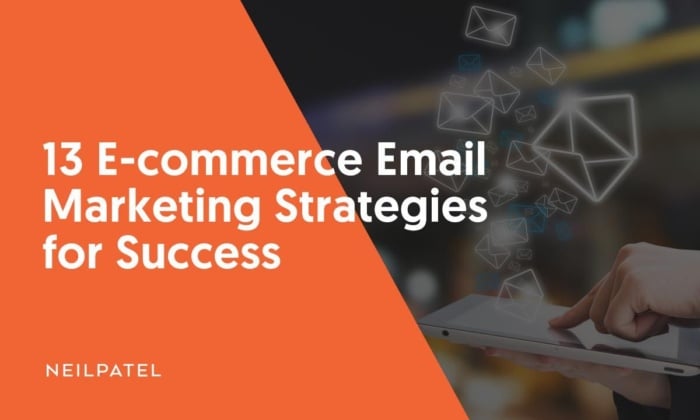
There are plenty of e-commerce marketing channels available to grow your business, such as social media, PPC, SEO, and network marketing.
With this said, successful e-commerce business owners know that e-commerce email marketing is one of the most profitable channels around.
Today, we’ll discuss how to use email marketing for e-commerce, targeted email strategies, and why online businesses should use them.
We’ll also share some e-commerce email marketing examples for you to learn from and we’ll delve into the 13 best strategies you can implement immediately for great results.
Key Takeaways
- E-commerce email marketing is one of the most profitable channels for growing your business.
- E-mail marketing provides essential data, allowing you to directly attribute sales to your efforts and monitor your ROI.
- E-commerce email marketing offers a direct glimpse into the human psyche and buying behavior, allowing you to keep purchasers engaged and coming back for more.
- Implementing the right e-commerce email marketing strategies like compelling calls to action, using personalization, and performing split tests can help you increase engagement and conversions.
- Continually testing and analyzing your email campaigns identifies areas for improvement and optimizes your results.
What Is E-Commerce Email Marketing?
E-commerce email marketing is a marketing channel that enables you to send marketing messages to current and potential customers. And when it comes to connecting with your customer, you don’t need to overthink it. For example, you could send:
- Exclusive, time-limited deals.
- New products and featured offers.
- Welcome and follow up messages.
Whatever you choose to send, the ultimate goal is to increase customer engagement and drive conversions.
E-Commerce Email Marketing Types
There are three different types of email marketing emails:
- Transactional emails include order confirmations, thank you emails, dispatch notifications, and welcome emails. They’re an essential part of the sales cycle, keeping customers informed throughout.
- Promotional emails are sales emails that include time-sensitive deals, new product launches, sales and discounts, and contests. But don’t send these emails too often, or you risk getting unsubscribed from. Once a week is enough for marketing emails.
- Lifecycle emails relate to shopping cart abandonment, welcome, and re-engagement emails. Lifecycle emails can increase conversions by ensuring you send the right message, to the right customers, at the right time.
Why Should E-Commerce Businesses Do Email Marketing?
As an e-commerce business owner, you’ve probably heard the sales pitch for just about every marketing channel there is.
You may even dabble in e-commerce email marketing currently, but perhaps you don’t understand how valuable it is to your sales strategy.
Kim Scoppetta – Senior Director of Content at NP Accel, highlights this importance:
“E-commerce email marketing is an immediate reward. You can directly attribute sales to your email marketing efforts and see your ROI faster because of the shorter buying cycle. It’s also a direct glimpse into the human psyche and buying behavior — we all have that honeymoon phase with a brand when we first meet them and want constant communication. From there, it’s on us as marketers to provide information to keep purchasers engaged and coming back.”
Aside from the quick gains, there are other benefits to email marketing for your e-commerce business, too. These include:
- Increased brand awareness: E-commerce email marketing allows you to reach a larger audience and effectively promote your brand. By sending targeted and engaging emails to subscribers, you can create awareness about your brand, products, and services.
- High-intent customers: Subscribers have a genuine interest in your product. If they’ve signed up, they’re keen to get more information and more likely to convert.
- Increased customer retention: Personalized emails and helpful post-purchase emails, like product hacks and info, make customers feel valued and more likely to stay with you.
- Direct communication with customers: By sending helpful, relevant content through newsletters, product updates, and promotions, you build customer relationships and ensure your business stays on people’s minds.
We also can’t ignore the conversion rate that email marketing delivers—a whopping 3,600 percent ROI!
10 Best E-Commerce Email Marketing Strategies
Our best e-commerce email marketing strategies will provide you with a solid foundation to build your email marketing empire. Let’s go.
1. Start With a Welcome Series
For the best impression with new subscribers, establish a welcome email series. This gives you a chance to share your brand story, highlight your best products, and even offer a discount to drive sales.
Beyond that, a welcome series drives serious engagement. With an average open rate of 63.91 percent and an average click-through rate of 14.34 percent, it’s a great addition to your larger e-commerce email marketing campaign.
Why?
First and foremost, a welcome series implies more than one email. Two or three emails are the sweet spot, and anything beyond that is considered “spammy” and may scare off new subscribers.
With two emails, you have the chance to welcome the customer and invite them to connect. With three emails, you can do the previous two while also getting to know the customer more personally.
Take, for example, the Wynd welcome series below. The air purifier brand’s first email offers subscribers a free filter with a purchase of $99 or more and highlights subscriber benefits. The follow-up focuses on product and service details.
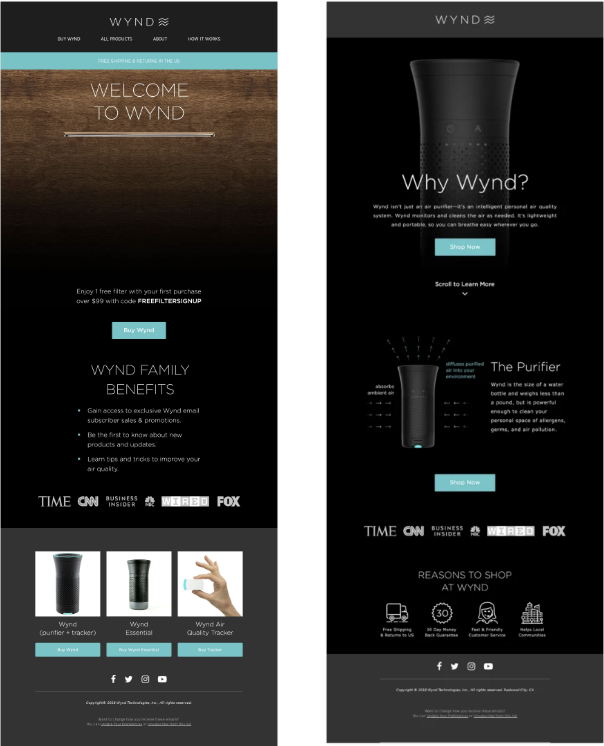
Whether you choose two or three emails, you want to be sure to include a few key elements in each email.
The initial welcome email should:
- Thank the subscriber
- Welcome them to the brand
- Let them know what to look forward to in future emails
If you made a promise upon sign-up, like a discount, include that, too.
The second welcome email should then:
- Give subscribers a further way to connect through mobile apps or social media
- Focus on the value you or your products can provide to their lives
- Tell them why they should purchase
2. Include a Clear Call to Action
What do you want your subscribers to do? Your e-commerce email marketing strategy won’t work unless you tell them.
Seriously, don’t underestimate the power of the call to action. A CTA prompts users to read a newsletter, on a website, or in a video to make that click. It’s usually a button or hyperlink that will help the user to achieve the goal.
According to Unbounce, including just one clear CTA in emails boosts clicks by 371 percent and sales by 1617 percent. HubSpot says personalizing your email’s CTA can improve its performance by up to 202 percent.
When it comes to effective CTAs, clear and concise is the way to go.
Create a compelling call-to-action for your email marketing campaigns by:
- Knowing the end goal.
- Using action-oriented words.
- Addressing your audience in the first person.
- Keeping your messaging short and snappy.
- Adopting a conversational tone.
You should also regularly A/B test your CTAs. This means testing variations of your preferred CTAs to see which elements, such as verbs, button shape/color, length, and word order, your users respond to best.
For example, PartnerStack experienced an increase of 111.55 percent in their conversion rate just by changing “Book a Demo” to “Get Started.”
3. Use Personalization to Segment Your List
When was the last time you received an email that was specifically tailored to you?
If you’re like most people, that email had a greater chance of compelling you to act.
In fact, WoodPecker found that emails with customized snippets had a 17 percent response rate, while emails without it peaked at 7 percent.
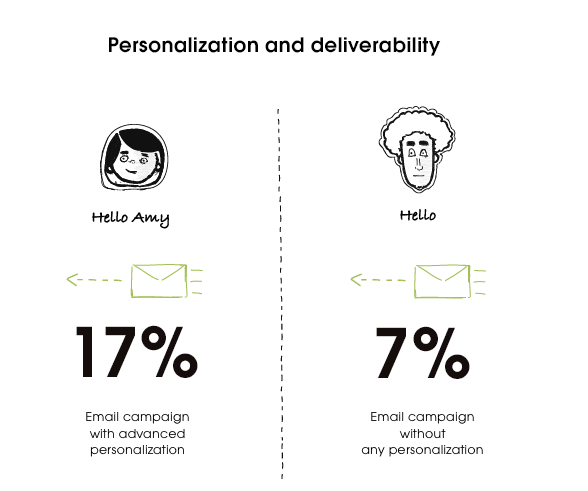
Personalized e-commerce email marketing has three categories: contextual, demographic, and behavioral.
- Contextual personalization utilizes where a customer is in their journey. For example, just beginning to research the topic or being ready to make a buying decision.
- Demographic personalization utilizes demographic information such as age, gender, location, and household income level to inform recommendations.
- Behavioral personalization uses past purchases or website behavior (e.g., abandoned carts).
Depending on the size of your email list, you can even combine these categories to create intersections. For example, you could combine past purchases with new location-based recommendations.
As your segmentation becomes more specific, the e-commerce email marketing campaigns will become more personalized and, more likely than not, successful.
4. Automate What You Can
Campaign Monitor found that automated emails create 320 percent more revenue than non-automated emails.
Therefore, automated e-commerce email marketing campaigns can be an invaluable tool in your overall marketing strategy.
From a welcome series to cart abandonment to transactional emails to re-engagement campaigns, automated emails for e-commerce can level up your email marketing strategy.
Any e-commerce email platform worth its weight will publish advice to help you automate your emails.
Klaviyo, for example, has various blog posts on topics such as automation flows to consider. It also has an automation user guide so you can set up your flows successfully.
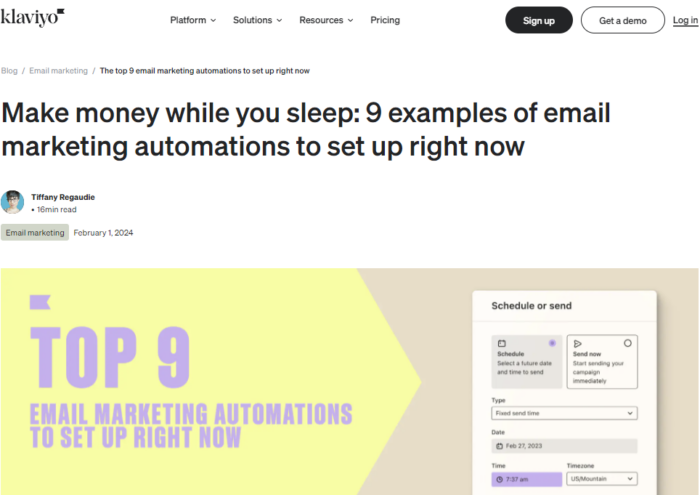
5. Create a Dynamic Cart Abandonment Series
A cart abandonment series can be one of your most profitable series. E-commerce carts have an abandonment rate of 69.9 percent, but there’s some good news for online sellers, too.
With an average open rate of 41.18 percent and a click rate of 9.50 percent, abandonment emails offer great opportunities for conversion.
When creating one, consider:
- The number of emails in the series: Three or four emails typically work best.
- The frequency of and intervals between each email: Try sending one email an hour after the cart abandonment, another the day after, and your final one three days later.
- Discounts to offer: If you want to secure a sale, try offering a discount code on the products they have in their cart.
- Subject lines: Subject lines strongly influence the CTR of your cart abandonment series and can ensure that your audience opens your email and reads the information you provide.
- Calls to action: Your CTA must convince prospective customers to return to their carts.
Additionally, your cart abandonment series can be a great place to personalize. The obvious one here is to include the products left behind in the cart like Sports Direct does below:

6. Perform Split Testing
How do you know whether your e-commerce email marketing campaigns are as effective as possible?
Without split testing, you don’t!
Split testing (sometimes called A/B testing) is a strategy that pits two or more similar variations of an element against one another.
For example, a split test may test the efficiency of two CTA buttons, one black with white text and one white with black text.
The goal is to find the best variations of common email elements to ensure that your emails have the greatest return on investment—such as testing user experience design elements.
This can result in better conversion rates of up to 127 percent.
Try to test:
- subject lines
- preview text
- product imagery
- layout
- image size
- font size
- font color
- button color
- send day and time
- copy
- pricing and discounts
- social media icons
When it comes to running successful split tests, there are some ground rules to follow:
- Stick with one variable at a time.
- Identify your goal.
- Know your “control” and your “challenger.”
- Split your groups equally and randomly.
- Decide significance parameters.
Once you have statistically significant (as determined by you) results in hand, it’s time to implement changes if necessary.
7. Use Email to Encourage Engagement
We’ve touched briefly on engagement in the welcome series section. However, you don’t need to reserve engagement emails only for welcome email campaigns.
Sending newsletters as part of your e-commerce email marketing offers a unique opportunity to capture your audience. This is especially true if open rates are high, but click-through rates are lacking.
Segment your audience according to their engagement and deliver appropriate messages accordingly.
Subscribers who have previously converted, for example, are 74.7 percent more likely to do so again.
Here, you would want to capitalize on brand trust. Ask yourself:
“Why did the customer buy from me before? Why should they do so again?”
This would be a good opportunity to send a product recommendation email based on their previous purchase. Like this example from Cartridge People:
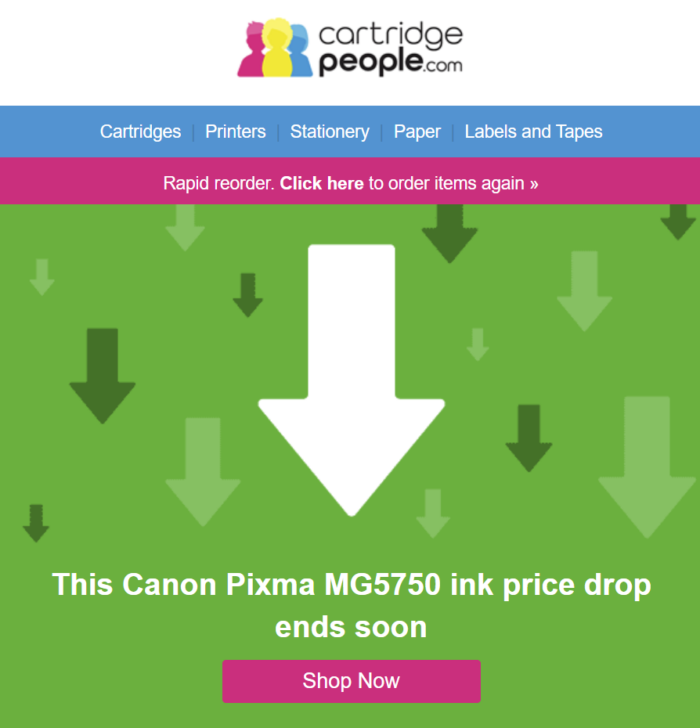
If it’s a consumable product, then a subscription offer email is easy enough. If it’s a non-consumable product, then a complementary product email is a safe bet.
For subscribers who have yet to convert, focus on building brand trust and offering discounts to make a purchase less risky.
8. Offer Exclusive Experiences and Rewards to Loyal Subscribers
Segmentation makes it easier to personalize emails and reward loyal customers with targeted email marketing.
By segmenting your email list by longtime subscribers or the greatest money spent, you can provide an exclusive experience that makes them feel valued by your brand and enhance your e-commerce email marketing efforts.
Notice I say experience and reward as opposed to discount.
Can a discount be a reward? Absolutely. However, discounts do have a downside. In particular, they can cheapen your brand’s value, especially in the eyes of loyal customers.
A loyal customer knows the value of your product.
Instead of a discount offer, consider an experiential reward. Millennial spending habits also back this. After all, 78 percent of millennials would rather spend their money on an experience than a product.
What options can you offer instead? You could:
- Give away once-in-a-lifetime trips.
- Offer meet-and-greet events with brand ambassadors.
- Make a brilliant rewards program.
- Design a top-tier social media group where you host virtual events.
9. Set Up Back In Stock or Wishlist Emails
We’ve touched on the importance of automated emails as part of your email marketing for e-commerce strategy, and we’ve even covered two automated campaigns in particular:
- A welcome series.
- A cart abandonment series.
The next on our list to highlight is the back-in-stock (or “wishlist” emails).
With recent constraints on the supply chain, more brands than ever have had item stocking and inventory troubles. That’s when you need to send a back-in-stock email.
As the name suggests, back-in-stock emails alert customers when a product they expressed interest in is back in stock and available to purchase.
Depending on your platform, a back-in-stock email option may be a product page feature, or it may require additional configuration (and add-ons like an app).
However much effort it takes on your part, the return is worth it!
According to a study by Barilliance, back-in-stock emails had the highest open rate (65.32 percent) when compared to alternative post-purchase emails.
10. Utilize Dynamic Content
We already know that personalization drives conversions.
The same can be said for dynamic content, a subset of personalization that has been shown to increase email ROI by 100 percent!
What is dynamic content, though?
Dynamic content is personalized content generated based on user signals:
- Product recommendations are based on past purchases or products that have been previously viewed.
- Calls to action tailored to the user’s browsing behaviors.
- Free exclusive offers (such as ebooks and white papers) for someone in the “research” stage of the buyer’s journey.
With most major email marketing software companies, dynamic content will be an impressive addition to most e-commerce email marketing templates.
Incidentally, if you’re searching for the best email marketing software for e-commerce, I have a couple of handy pieces about email software for small businesses and services to get you started.
11. Implement Product Recommendation Emails
One of the simplest ways to improve customer engagement is to send them emails personalized to their needs, interests, and preferences.
Product recommendation emails can also improve customer experience, enhance customer loyalty, and even make the shopping experience more enjoyable.
Why? Because you’re sending your customers relevant offers that they’re more likely to respond to.
You probably get tons of weekly emails and delete most of them because they don’t interest you. Production recommendation emails have the opposite effect, providing subscribers with products they love and tempting them to click through and convert.
To personalize your e-commerce email marketing recommendations, just comb over your customer data and look at customers’ browser history to find products suitable for specific subscribers’ interests.
You can send these emails routinely, during new product launches, or for seasonal events. Ensure you maximize sales through complimentary products, time-limited discounts, and exclusive offers.
Personalize the headlines, too.
12: Optimize for Mobile
Still not optimizing for mobile? You definitely should.
53 percent of marketers say one of their top email marketing strategies will be mobile design, and rightly so.
According to eMarketer, 55 percent of consumers open their emails on a mobile device. That makes mobile responsiveness essential if you want your customers to have a seamless user experience across all devices.
To make your emails mobile responsive:
- Use mobile-responsive email templates. Companies like Emailmonday offer them, and Colorlib has a list of 36 responsive templates.
- Keep text short and sweet, and use bullet points and short paragraphs for easy scanning.
- Optimize image sizes for mobile and compress larger images for faster loading. Remember to add descriptive alt-text for accessibility.
- Use large, clear fonts. Arial, Verdana, and Helvetica all work well online. The font size for body text should be 14-16.
13. Leverage Social Proof
By using customer reviews, testimonials, and user-generated content (UGC) in your e-commerce email marketing campaigns, potential buyers get feedback and examples from others already enjoying your products.
Aside from more traditional methods like reviews and testimonials, UGC is a highly effective way to drive click-throughs and conversions. For instance, an e-commerce clothes store showing pictures of genuine customers wearing your clothes enables customers to see what the products look like “live.”
Be sure to get permission from customers before using their content, and be selective in what you showcase—only include relevant, high-quality content that aligns with your brand values.
FAQs
How much should I make from e-commerce email marketing?
What you earn from e-commerce email marketing is relative to what you invest. With an average of ROI $36 earned for every $1 spent, you’re likely to earn more from e-commerce email marketing than most (if not all) other marketing channels.
How does e-commerce use email marketing?
E-commerce relies heavily on email marketing as a way to connect with both current and prospective customers. It’s used as a way to promote new products, communicate exclusive offers and deals, and engage with the target audience.
How do I start e-commerce email marketing?
To start e-commerce email marketing, all you need is an email marketing software, some e-commerce email templates, and one or two fully fleshed-out campaigns. The rest will fall into place as you grow your subscriber list.
How important is email marketing for e-commerce companies?
Email marketing for e-commerce is a critical part of any effective online marketing strategy, helping to engage customers, enhance loyalty, and encourage click-throughs. Without email marketing, you could be leaving tens or even hundreds of thousands of dollars on the table.
Conclusion
Whether you’re a new or seasoned e-commerce business owner, email marketing should be a major part of your overall marketing strategy.
It’s not difficult to get started, and once you do, you will have the best e-commerce email marketing strategies to help make your campaigns successful.
In this piece, I’ve detailed 13 easy-to-implement e-commerce email marketing best practices to help you get on top of your email game.
Tactics like including compelling calls to action, using personalization, and performing split tests can enable you to get the best results.
With these strategies in place, you’ll know that you’re doing everything you can to boost engagement and conversions.
Continue reading...
